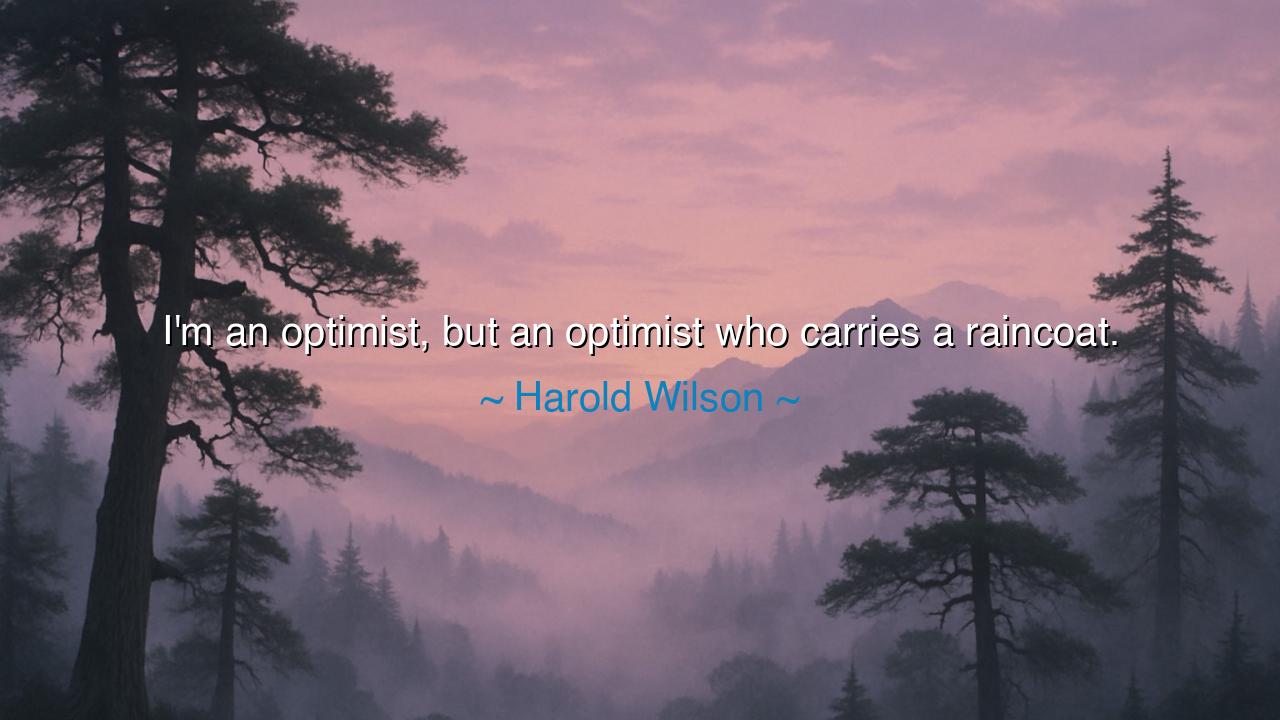
I'm an optimist, but an optimist who carries a raincoat.






When Harold Wilson said, “I’m an optimist, but an optimist who carries a raincoat,” he spoke with both humility and wisdom, acknowledging the balance that all must find between hope and prudence. Wilson, a British politician and a man known for navigating turbulent political landscapes, understood that optimism is not merely about anticipating the best outcomes, but also about being prepared for the storms that inevitably come. His words are an expression of the ancient wisdom that true optimism is not blind; it is grounded in realism. To hope is powerful, but to prepare for adversity is wise. Wilson’s raincoat is not a symbol of cynicism but of practicality — an acknowledgment that the road ahead may be uncertain, but we move forward regardless, ready to face whatever challenges may arise.
In the ancient world, the Stoics espoused a similar view of life. Epictetus, for example, taught that we should embrace challenges as part of the human experience, not something to be feared or avoided. He believed that while we cannot control the external world, we can control our reaction to it. Wilson’s raincoat is a modern symbol of this Stoic ideal: the optimist who does not deny the possibility of storms, but carries with him the means to endure them. Just as a Stoic would carry his inner strength, Wilson suggests that we must carry practical tools to weather life’s inevitable challenges — both in our hearts and in our minds.
The meaning of Wilson’s quote is that optimism should not be a naive, unguarded hope. To be an optimist is to believe in the possibility of a bright future, but it also requires us to accept that the future is never certain, that trouble may be lurking even when the skies appear clear. True optimism, as Wilson suggests, is about maintaining hope while acknowledging the realities that lie ahead. It is about seeing the potential for growth and progress, while also carrying the wisdom of preparation and adaptability. It is a balance of believing in the possibility of good outcomes while being ready to face whatever may come.
This insight is echoed in the story of Thomas Edison, one of the greatest inventors of modern history. Edison was not merely an optimist; he was a relentless realist. He faced countless failures in his quest to create the electric light bulb, and yet, he famously said, “I have not failed. I’ve just found 10,000 ways that won’t work.” His optimism was tempered with a constant willingness to prepare, to persevere, and to learn from every setback. Like Wilson, Edison understood that success is not achieved by blind hope alone; it is achieved through preparation, resilience, and the willingness to confront difficulties head-on.
The lesson in Wilson’s words is timeless: to be optimistic is to embrace the future with hope, but that hope must not be devoid of wisdom. It must be informed by experience, understanding, and practicality. An optimist, like the sailor who sets out to sea with hope in his heart, must also pack his raincoat. He must understand that the journey may not always be smooth, that the winds may turn, and the skies may darken. But, with preparation, he can weather the storm and continue forward, not in despair, but in hope.
In today’s world, filled with uncertainty, optimism is often in short supply. The world moves faster than ever, and yet we are constantly confronted by news of crises, disasters, and difficulties. But in the face of these challenges, the true optimist does not ignore the dangers. Rather, they prepare. They don’t wait for the storm to pass; they set out in the rain, knowing that the storm is but a temporary obstacle in their pursuit of progress. The optimist carries their raincoat — the tools, the knowledge, and the inner strength to continue moving forward despite the obstacles.
The lesson is clear: optimism does not mean blindly hoping for the best; it means preparing for the worst while believing in the possibility of good. Carry your raincoat, whatever form it may take — whether it’s your knowledge, your skills, or your resilience — and meet the future with both hope and practicality.
Practical actions for the true optimist:
-
Prepare for challenges: Recognize that setbacks and difficulties are part of the journey. Equip yourself with the tools, knowledge, and mindset to face them.
-
Stay adaptable: Cultivate flexibility in your plans, knowing that life may not always unfold as expected. Adapt with grace and strength.
-
Learn from adversity: When obstacles arise, embrace them as opportunities to learn and grow, just as Edison did in his thousands of failures.
-
Maintain hope in the face of hardship: Let your optimism fuel your determination to move forward, no matter the setbacks.
For as Harold Wilson reminds us, optimism is a powerful force, but it is the optimist who prepares — who carries their raincoat — who is truly ready for the storms of life. Keep your hope alive, but always be prepared for the challenges that lie ahead. In this balance, you will find the strength to weather any storm and the courage to move forward, no matter the obstacles.






AAdministratorAdministrator
Welcome, honored guests. Please leave a comment, we will respond soon